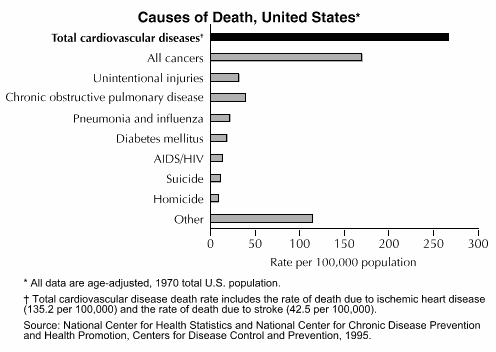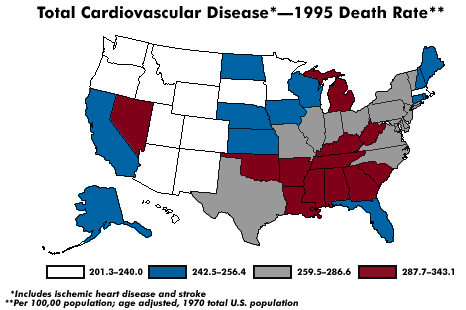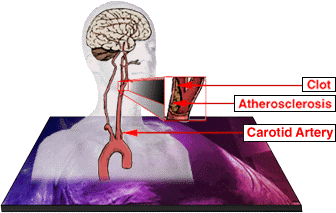
| HealingWithNutrition.com 1-800-943-1123 | Home | SiteMap | Education | Products |

Cardiovascular Disease
|
|---|
|
Leading Cause of Death
in the United States One person dies
every 30 seconds from heart disease, that's over 2,600 people every single day! |
Cardiovascular disease (CVD), principally heart disease and stroke, is the Nation's leading killer for both men and women among all racial and ethnic groups.
Almost 1 million Americans die of CVD each year, which adds up to 42% of all deaths.
Heart disease doesn't just kill the elderly -- it is the leading cause of death for ALL Americans age 35 and older. Heart disease accounts for over one million deaths each year; in 160,000 of those deaths the individuals were 35 to 64 years old.
Early medical detection and treatment is available, but the effectiveness of this in actually preventing heart attacks is questionable according to a study that was published in the journal Circulation.
In this study, Dr. Lewis Kuller reviewed the medical records of 326 individuals who had received medical examinations within the six month period before they died from a sudden heart attack. Eighty-six of the 326 examinations were done within the seven day period prior to death from heart attack. Not a single one of the 326 heart attacks had been predicted by the physicians.
The death toll alone is a staggering burden, but it is only part of the picture. The rest of the picture is filled with individuals who daily struggle with the complications of CVD. One out of every four Americans has CVD, that converts to about 57 million Americans. Heart disease and stroke account for almost 6 million hospitalizations each year and cause disability for almost 10 million Americans age 65 years and older.

CVD costs the nation $274 billion each year, including health expenditures and lost productivity. The 1999 cost is estimated to be $286.5 billion, and the burden continues to grow as the population ages.
Until fiscal year (FY) 1998, NO Federal Funding had been directed to states to target CVD.
According to studies conducted by the U.S. Center for Disease Control where you live might affect your exposure to factors causing heart disease (i.e. environmental pollution, daily stress, lifestyle behaviors).

Cardiovascular Disease (CVD) includes dysfunctional conditions of the heart, arteries, and veins that supply oxygen to vital life-sustaining areas of the body like the brain, the heart itself, and other vital organs. If oxygen doesn't arrive the tissue or organ will die.
 Ischemic Heart Disease is the technical term for obstruction of blood flow to the heart. In general this results because excess fat or plaque deposits are narrowing the veins that supply oxygenated blood to the heart. Excess buildup of fat or plaque are respectively termed arteriosclerosis and atherosclerosis. Equally significant would be inadequate oxygen flow to the brain, which causes a stroke.
Ischemic Heart Disease is the technical term for obstruction of blood flow to the heart. In general this results because excess fat or plaque deposits are narrowing the veins that supply oxygenated blood to the heart. Excess buildup of fat or plaque are respectively termed arteriosclerosis and atherosclerosis. Equally significant would be inadequate oxygen flow to the brain, which causes a stroke.
High Blood Pressure (hypertension) often results from this excess fat or plaque buildup because of the extra effort it takes to circulate blood. Even though the heart works harder, blockages still shortchange the needed blood supply to all areas of the body. The body's amazing survival systems will mask the subtle damage that is occurring from this extra wear and tear, but not forever. High blood pressure is called "The Silent Killer" because the first warning sign is an angina attack or a deadly heart attack or a stroke.
Kidney disorders (which leave extra fluids, sodium, and toxins in the body), obesity, diabetes, birth control pills, pregnancy, smoking, excess alcohol, stress, and thyroid and adrenal gland problems can also cause and exacerbate a high blood pressure condition.
Damage to the heart tissues from CVD or from heart surgery will disrupt the natural electrical impulses of the heart and result in cardiac arrhythmia (an abnormally high or abnormally low heart rate). Individuals often don't realize the aftermath and side effects that invasive surgical procedures leave. Sudden fluctuations in heart rate can cause noticeable palpitations, with an associated faintness, or dizziness, and if severely abnormal could interfere with blood flow and even initiate a heart attack.
Proper ranges of cholesterol are also important in the prevention of heart attack or stroke. Total blood cholesterol above 200 mg/dl, LDL cholesterol above 130 mg/dl, HDL cholesterol below 35 mg/dl; and lipoprotein(a) level greater than 30 mg/dl are indicators of problematic cholesterol. Cholesterol is not actually a damage mechanism but is more an indicator of compromised liver function, and increased risk of heart attack.
Infection of the heart, carditis and endocarditis, is an additional complication that can occur as a result of a weak immune system, liver problems, heart surgery, or from an autoimmune disorder like rheumatic fever. Endocarditis is quite common in persons with compromised immune systems from HIV or AIDS. If not appropriately handled, permanent heart muscle damage can occur from the infection.
Many scientific studies validate the effect diet and supplements can have for the body to heal damages to the cardiovascular system. Lifestyle changes can also make a big difference."Angiograms, bypass surgery, and angioplasty are a big business. Over one million heart angiograms are performed each year for a total annual cost of over ten billion dollars. But based upon extensive analysis, it appears that most of this money is wasted. The use of expensive surgery is physically invasive and traumatic for the heart patient, and upon evaluation of case histories has been shown to be five to ten times more deadly than the disease, and in many instances unnecessary!" [As reported in: Graboys, et. al. 1987 Journal of the American Medical Association; Graboys, et. al. 1992 Journal of the American Medical Association; Coronary Artery Surgery Study (CASS) 1984 New England Journal of Medicine; CASS study, Alderman, et. al. 1982 and 1990 Circulation (Journal)].
Our Personal Framework for Cardiovascular Disease Nutritional Support will give you this nutrient association information as well as other helpful lifestyle changes for managing the disease. We also include the Center for Disease Control Framework for Cardiovascular Disease Nutritional Support to help you understand on a large scale what the government is doing.